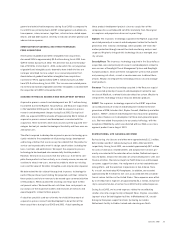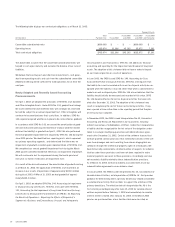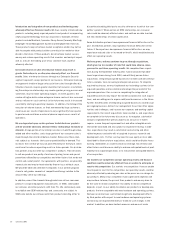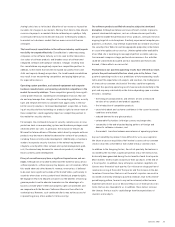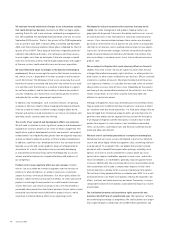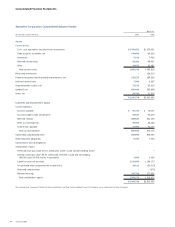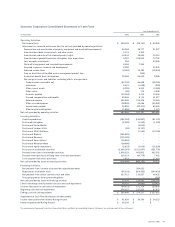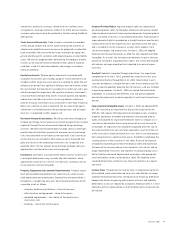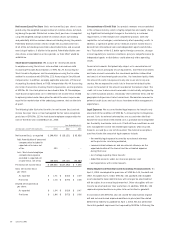Symantec 2003 Annual Report Download - page 42
Download and view the complete annual report
Please find page 42 of the 2003 Symantec annual report below. You can navigate through the pages in the report by either clicking on the pages listed below, or by using the keyword search tool below to find specific information within the annual report.
40 Symantec 2003
We continue to make substantial changes to our information systems
that could disrupt our business. During fiscal 2002, we began imple-
menting Oracle 11i and a new customer relationship management sys-
tem. We completed the worldwide implementation of Oracle 11i in the
September 2002 quarter. The first four phases of the CRM implementa-
tion occurred in June 2001, February 2002, June 2002 and November
2002, with the remaining implementation phase scheduled for the first
quarter of fiscal 2004. These types of transitions frequently prove dis-
ruptive to the underlying business of an enterprise and may cause us
to incur higher costs than we anticipate. Failure to manage a smooth
transition to the new systems and the ongoing operations and support
of the new systems could materially harm our business operations.
We must effectively adapt to changes in the dynamic technological
environment. We are increasingly focused on the Internet security mar-
ket, which, in turn is dependent on further acceptance and increased
use of the Internet. The following critical issues concerning the use of
the Internet remain unresolved and may affect the market for our prod-
ucts and the use of the Internet as a medium to distribute or support
our software products and the functionality of some of our products:
security; reliability; cost; ease of use; accessibility; quality of service;
and potential tax or other government regulations.
In addition, new technologies, such as wireless devices, are gaining
acceptance. We must adapt to these changing technological demands.
If we are unable to timely assimilate changes brought about by the
Internet and wireless based environments, our future net revenues and
operating results could be adversely affected.
The results of our research and development efforts are uncertain.
We will need to continue to incur significant research and development
expenditures in future periods as we strive to remain competitive. The
length of our product development cycle for new products and product
enhancements has frequently been greater than we originally expected,
and we are likely to experience delays in future product development.
In addition, a portion of our development efforts has not been techno-
logically successful and certain products have not achieved market
acceptance. As a result, the products we are currently developing
or may develop in the future may not be technologically successful,
achieve market acceptance or compete effectively with products of
our competitors.
Product returns may negatively affect our net revenues. Product
returns can occur when we introduce upgrades and new versions of
products or when distributors or retailers have excess inventories,
subject to various contractual limitations. Our return policy allows dis-
tributors, subject to these contractual limitations, to return purchased
products in exchange for new products or credit towards future pur-
chases. End-users may return our products for a full refund within a
reasonably short period from the date of purchase. Future returns could
exceed the reserves we have established for product returns, which
could have a material adverse effect on our operating results.
We depend on internal communications systems that may be dis-
rupted. Our order management and product shipping centers are
geographically dispersed. A business disruption could occur as a result
of natural disasters or the interruption in service by communications
carriers. If our communications between these centers are disrupted,
particularly at the end of a fiscal quarter, we may suffer an unexpected
shortfall in net revenues and a resulting adverse impact on our operat-
ing results. Communication outages, Internet connectivity disruptions,
and/or increased volumes of electronic distribution transactions may
also cause delays in customer access to our Internet-based services or
product sales.
We are subject to litigation that could adversely affect our financial
results. From time to time, we may be subject to claims that we have
infringed the intellectual property rights of others, or other product lia-
bility claims, or other claims incidental to our business. We are currently
involved in a number of lawsuits. We intend to defend all of these law-
suits vigorously. However, it is possible that we could suffer an unfavor-
able outcome in one or more of these cases. Depending on the amount
and timing of any unfavorable resolutions of these lawsuits, our future
results of operations or cash flows could be materially adversely
affected in a particular period.
Although infringement claims may ultimately prove to be without merit,
they are expensive to defend and may consume our resources or divert
our attention from day-to-day operations. If a third party alleges that we
have infringed their intellectual property rights, we may choose to liti-
gate the claim and/or seek an appropriate license from the third party.
If we engage in litigation and the third party is found to have a valid
patent claim against us and a license is not available on reasonable
terms, our business, operating results and financial condition may be
materially adversely affected.
We must attract and retain personnel in a competitive marketplace.
We believe that our future success will depend in part on our ability to
recruit and retain highly skilled management, sales, marketing and tech-
nical personnel. To accomplish this, we believe that we must provide
personnel with a competitive compensation package, including stock
options. Increases in shares available for issuance under our stock
options plans require stockholder approval in many cases, and institu-
tional stockholders, or stockholders generally, may not approve future
increases. Additionally, the accounting industry has recently determined
that corporations will include a compensation expense in their state-
ment of operations relating to the issuance of employee stock options.
This will most likely become effective in calendar year 2004. As a result,
we may decide to issue fewer stock options and may be impaired in our
efforts to attract and retain necessary personnel. Conversely, issuing a
comparable number of stock options could adversely impact our results
of operations.
Our intellectual property and proprietary rights may not be ade-
quately protected from all unauthorized uses. We regard our software
and underlying technology as proprietary. We seek to protect our propri-
etary rights through a combination of confidentiality agreements and





